In Antarctic Light
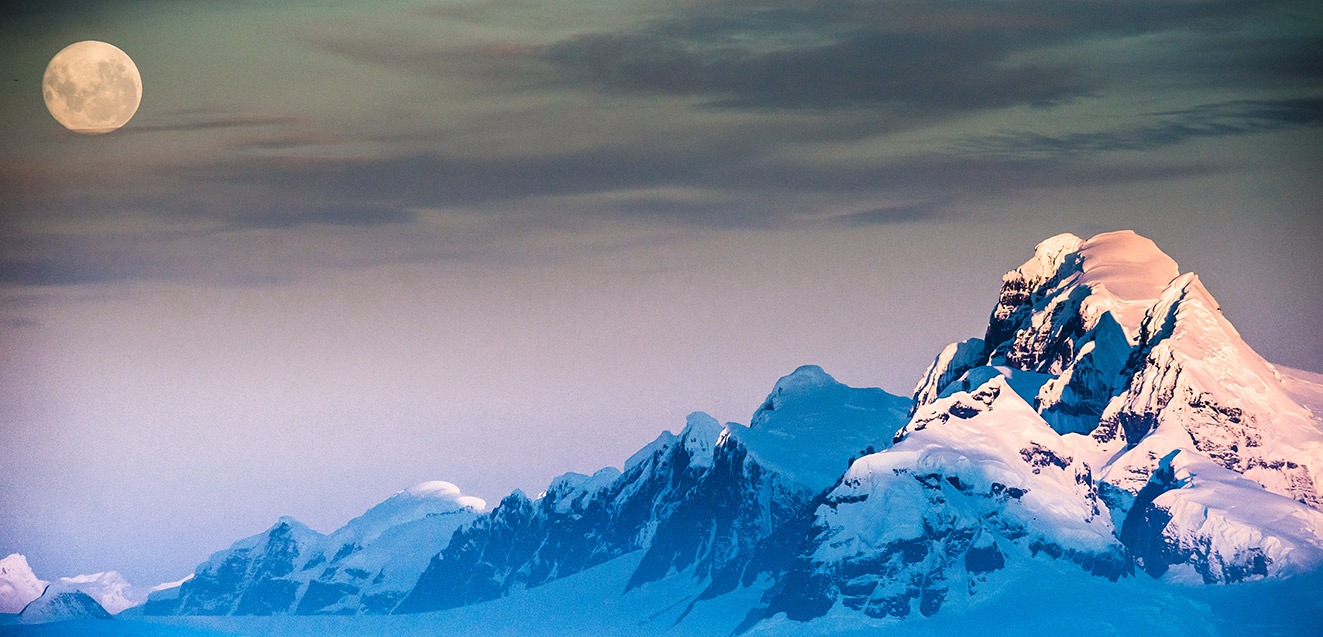
Surrounded by a curtain of ice and snow, I held tight to the rope in my hands. My teeth chattered as the cold bit into the little flesh I’d left exposed. As I struggled to gain purchase, I tried not to look toward the gaping maw of the mountain, a crevasse I knew was nearby but could no longer see. Instead, I searched for my fellow expeditioners in the scattering light, but there was nothing—no one. In every direction, there was only blinding whiteness.
My feet were slipping, and panic was taking hold.
I felt a tug at the rope, and exhaled. A second tug urged me on. I pulled back as if to say, “I’m on my way.” One step. I dug my toes into the snow. Another step. I just need to take it slow, I told myself. Another. Almost there.
Then a thunderous groan reverberated down the mountain—an avalanche.
Ding dong!
The doorbell rang, and the Transantarctic Range sank back into the beige-carpeted staircase from which it had risen. In my childhood home, the California sunshine streamed in and drove away the Antarctic snow, and the rope that had been a lifeline on a distant mountaintop just a moment before reverted to its natural form—my jump rope tied to the banister. I pulled off the oversized ski gloves I’d dug out of the hall closet and bounded down the stairs.
“Who is it?” I asked from behind the heavy wood of the front door. I couldn’t yet reach the peephole.
~~
Maps are poems. They’re paper dreams. They’re kaleidoscopic amalgamations of information and imagination.
When my parents bought me a behemoth atlas one Christmas, I lost myself in its pages. I could barely lift it, but I’d drag it into our family room and spread out on the carpet, hair falling into my eyes. Each reverent turn of the page promised a new adventure. I rafted azure rivers, climbed trees in emerald forests, and braved the sandstorms of golden deserts. But no map captivated me more than a two-page spread of a roughhewn continent rendered in shades of white and blue. A continent with no cities or towns. No rivers or forests or sand-swept deserts.
Could such a place really exist?
My parents assured me that it could—that it did. And that was it. I wouldn’t know it for decades—wouldn’t understand it for even longer—but my life was set on a collision course with Antarctica when I was five years old.
~~
In the years after I received the atlas, I fixated on the White Continent in the way children do, memorizing every name, story, and inane fact I could find. In that age before the Internet, I turned to volumes of the Encyclopedia Britannica at my local and school libraries to match the namesakes in my atlas with their eponyms: The Ross Ice Shelf. Named for James Clark Ross, who commanded the Erebus and the Terror. The Gerlache Strait. Named for Adrien de Gerlache, who commanded the Belgica, the first expedition to overwinter in Antarctica proper—not by choice.
The names of explorers, their ships, and the places of their greatest exploits became a language I spoke fluently. At night, I curled up under the covers in my bed long after the house stilled and read the stories of these voyagers by flashlight. And though it was clear these expeditions were hardships of the tallest order—that they frequently ended in amputated digits, physical illness, madness, and even death—I fell asleep dreaming of my own swashbuckling adventures sailing tempestuous seas, ascending ragged peaks, and dancing at the feet of danger.
~~
What does it mean for a childhood fantasy to come true?
~~
The full moon floated above the horizon, playing peekaboo from behind an iceberg. In the indigo waters of the Weddell Sea in the waning hours of a decade, reflected light illuminated the shadows and folds of the colossal tabular bergs before us—some as large as cities.
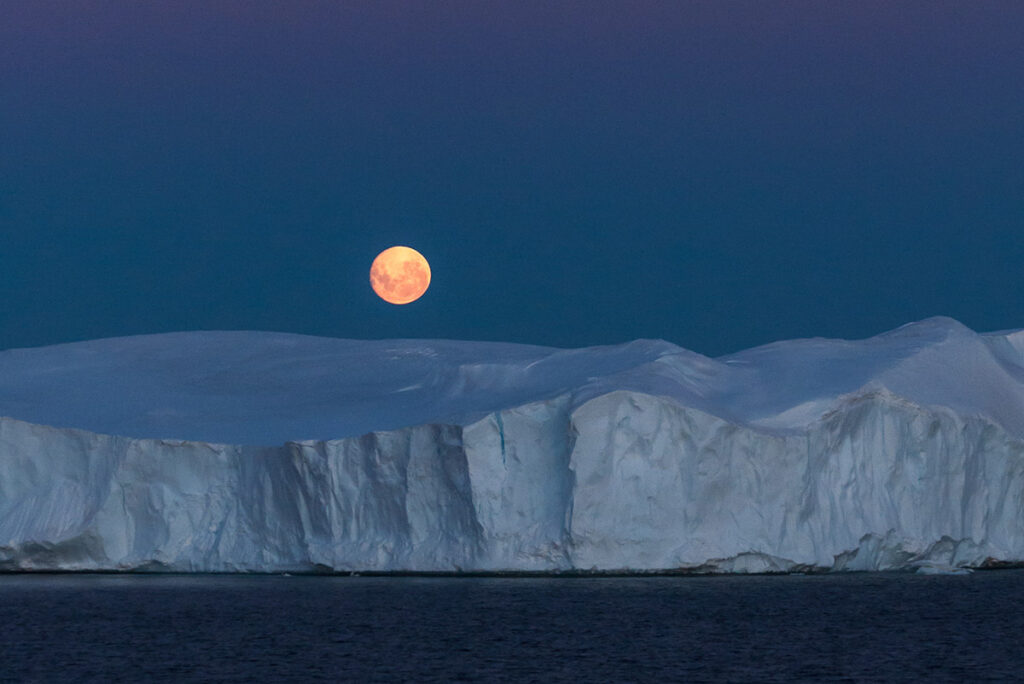
It was my first expedition to the White Continent, and I couldn’t yet fathom that it wouldn’t be my only expedition—that I would make the passage twice more in the next eight years. That I would trade the 367-foot, ice class vessel with stabilizers and chef-prepared meals for a 52-foot sailing yacht with a butchered lamb tied to its stern, then for a 297-foot former NOAA research vessel with a wild yaw that sent chairs, and sometimes people, somersaulting through rooms.
I couldn’t yet fathom that I would be anticipating my fourth sojourn even as I wrote these words.
At that moment on New Year’s Eve in 2009, on that very first trip, I was simply trying to wrap my mind around the light. It was warm, warmer, it seemed, than even the sunshine of those California afternoons. I soaked it in, listening to the sea lap at the hull of our ship as the captain throttled down the engine and we began to drift, meandering through the moonlight.
~~
Four years later, on Livingston Island, a downy penguin chick with comically large feet that it would eventually grow into, waddled into a patch of sunshine and stumbled toward me as I sat on the rocky ground.
For nine of us who’d set out from Argentina, this was the first landing of the trip, and a brutal, four-day sail across the Drake Passage had left most of us purpled with bruises and searching for our land legs. But on the island, the sun was shining, shimmering on the water and warming the rock-strewn landscape, so I’d found a quiet place to sit for a while, leaning back against my pack as my equilibrium recalibrated.
The ball of fluff flapped its flippers awkwardly as if trying to propel itself forward. Someday, the gray down would give way to black and white waterproofed feathers and those clumsy flippers would turn into precision rudders in the water. But for now, they just threw the chick off balance. It stumbled onto its belly and squeaked before righting itself and continuing toward me. I scooted back slowly, trying to keep my distance, but it closed in again, and after a few of these cycles, I gave up, instead watching the catchlight in its eyes.
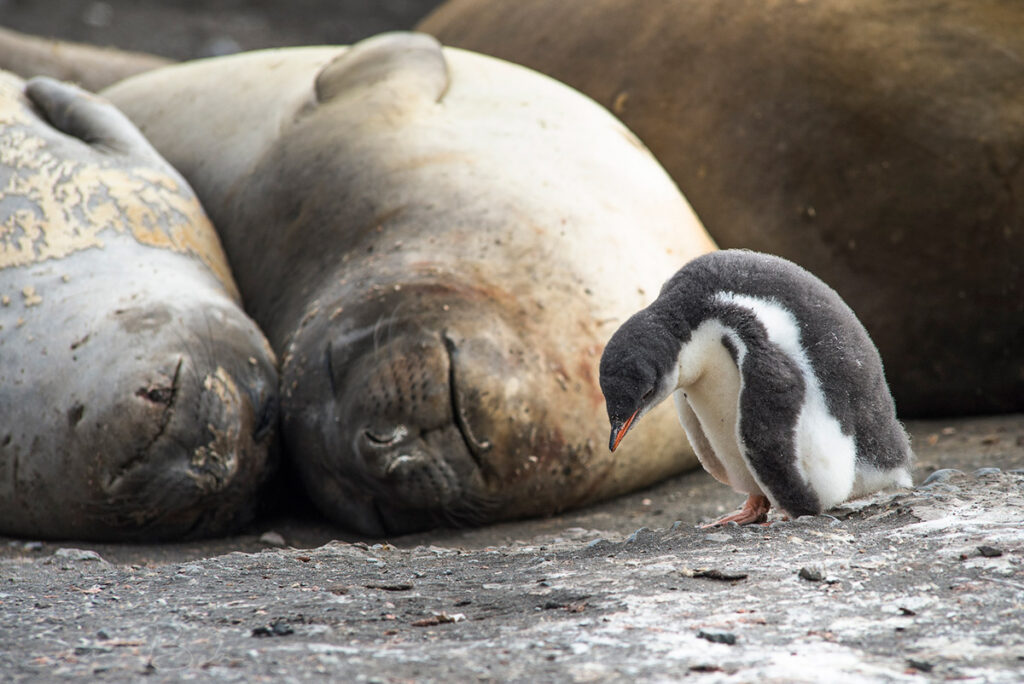
“Well, hello there,” I said, delighted as the curious chick tilted its head inquisitively and examined my feet before hopping up onto one of my boots.
~~
The iceberg materialized in the distance, towers and peaks, arches and spires coming into view as we drew near.
“Everyone comes down for the animals, but they come back for the ice.”
I heard the words like they’d just been uttered beside me, but they’d been said nearly a decade earlier by a woman whose name I couldn’t recall but whose tight, amber curls and toothy grin still occupied a place in my memory.
Regardless of the year or the vessel or the person standing at my elbow, this moment, watching an iceberg grow on the horizon as we near, would never change.
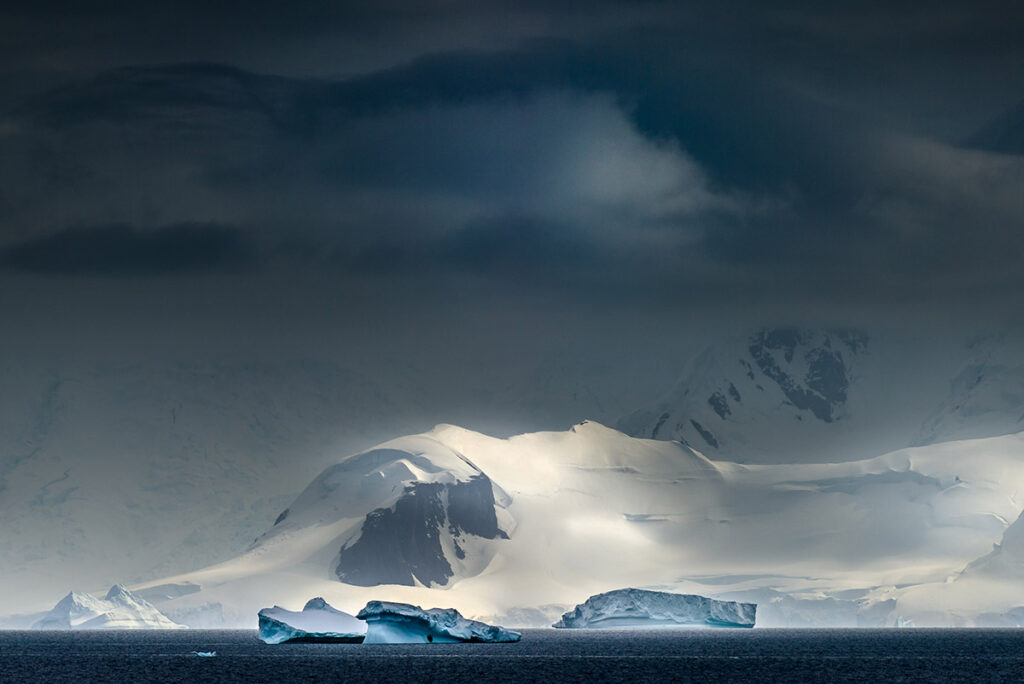
Early in the morning, while most of my tripmates slept, I stood alone on the deck as a feathery snow fell, and gazed out as dappled light escaped the clouds and danced across the water. The iceberg looked worn and smooth, gray and gothic. When we were as close to it as we dared get, the captain began to steer a wide arc.
“Wait for it,” I said quietly to myself.
Suddenly, the towering iceberg erupted in a cacophony of color and texture. The grays became saturated aquas, the smooth columns showed their undulating ripples. Arches rose from shallow cerulean pools while striped spires poked at the sky. This ancient ice, which had begun as snow in another millennium, came alive, bearing both the blueness of its age and the sculpted splendor of its life at sea.
With icebergs, the angle of light is everything.
~~
What does it mean for a childhood fantasy to come true?
~~
My shoulders ached. The heavy pack that hung from them held my camera gear as I climbed the small mountain, careful to keep my distance from the nesting pairs of gentoo penguins. I’d given up on keeping my distance from their rust-colored guano, which, at times, seemed to coat the mountainside, thick, slippery, and odiferous. It was deep into the night, but at the height of the Antarctic summer, the sun still burned.
My fellow expeditioners and I had largely scattered when we made land at Port Charcot on Booth Island. Philipp, a bearded mathematician and pianist from Oslo who also happened to be one of the more experienced mountaineers among us, set off on his own, his full form becoming a dot on a distant, crevasse-scarred mountain. I kept climbing. On the other side of the ridge above me, I knew, was an “iceberg graveyard,” a shallow bay where winds drove behemoth icebergs aground and left them to await their fate: either a rising tide and fair winds to carry the bergs back to sea, or, more likely, a slow melt in the sunshine.
Shifting my pack, I put one foot in front of the other, guessing the number of steps until I reached the top and then silently counting each one along the way, watching my breath condense in the crisp air. Snow and ice crunched beneath my boots, the sound mingling with the brays and bleats of the gentoos. A pair flopped onto their bellies and tobogganed down the hill, springing to their feet right before they hit the water and scrambling to keep from going in.
When I finally crested the ridge, a kingdom of ice stretched before me. The sky dripped a blood-orange light over the land and water as a fireball sun drifted lazily across the sky, slowly making its way toward the horizon. I gasped at the sight.
Then a thunderous groan reverberated across the island.
My head snapped toward the sound. An avalanche of snow tumbled down the mountainside in the direction Philipp had gone earlier. Another member of our group was nearby, and I looked at him hoping for reassurance. Surely Philipp was nowhere near the avalanche. Instead, I saw my own concern mirrored back at me.
~~
As a child, I had imagined moments like this—had wished for a life full of them. But I was no longer a child.
The minutes passed on Booth Island. How many? I couldn’t say. The avalanche settled but there was no sign of Philipp.
Until there was. There. A tiny black speck, snowshoeing on.
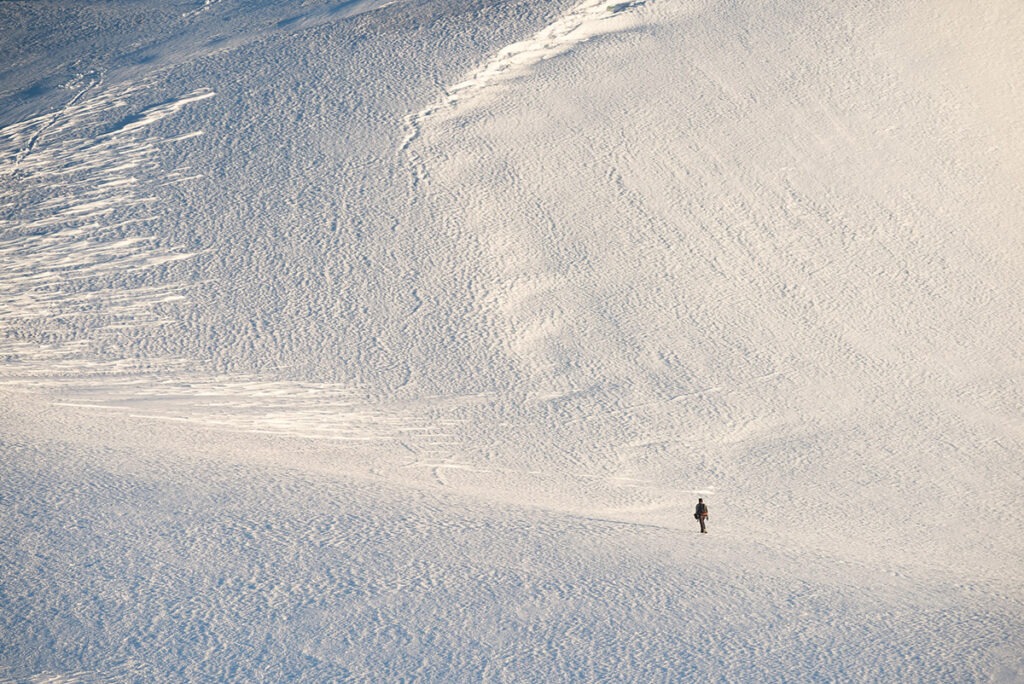
I unclenched my jaw, felt my grip on my camera loosen a little, and exhaled the tension. For a few moments, I kept my eyes on Philipp before finally turning my attention back to the still-blazing sunset—it would last for hours, I knew. When I’d reached the top of the ridge, I’d set my pack down to explore unencumbered. Now I turned back to retrieve it.
“Oh,” I said, surprised.
Behind me, a full moon was making an unhurried ascent through an easygoing lavender sky. The last remnants of the day glanced off the cap of Dayné Peak on neighboring Wiencke Island, the snow iridescent in the evening light. And off in the distance, a large bird, probably a petrel, soared toward the moon.
“Oh,” I said again, this time with reverence, remembering another full moon in Antarctica, one that rose on a new decade, deep in the Weddell Sea at the bottom of the world.
Once upon a time, I’d fallen in love with the idea of Antarctica as a volatile, unforgiving land, and it certainly was that. But this stillness, this even-tempered beauty, this was Antarctica, too, I realized. And more than that, this was the Antarctica I took with me when I left.
~~
Later that night, I sat at our boat’s narrow dining table, listening to a soundtrack of soft snores and even softer waves. Ensconced in the dim light of a single lamp, I scribbled away in my notebook.
I let my mind drift through space and time. I thought of the symphonic silence of a windless Antarctic day, the catchlight in the curious eyes of a fluffy penguin chick, the gentle curves of an ice palace floating in a still sea as snowflakes fell through the frigid air. I thought of the others sleeping nearby and our weeks of shenanigans and shared wonder. We’d started the trip as strangers, but thousands of experiences from sparkling sunrises to snowball fights had turned us into something else—something that felt more like family.
I thought of moonrises.
And I thought of that young girl in the California sunshine, paging through her atlas of dreams. She had seen more of the world now and she dreamed in different colors, but down in Antarctica, I was surprised to find she was still nearby.
What would she want? I asked myself.
The answer came without hesitation as I put pen to paper: “More nights like tonight. More people like these people. More moonrises.”
* * * * *
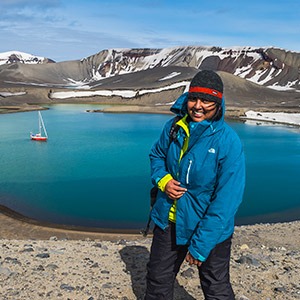
Sivani Babu is the co-founder and co-CEO of Hidden Compass and an award-winning nature photographer and journalist. Her work, which frequently meshes history, science, and exploration, has appeared in numerous national and international publications and dozens of exhibits worldwide. Her stories have also been anthologized in the Best Women’s Travel Writing and recognized multiple times in the Best American Travel Writing series. A former federal public defender, Sivani teaches storytelling as a tool for advocacy to law students across the country.
All images courtesy of Sivani Babu.
Sivani, this is magical. I hadn’t planned to visit Antarctica tonight, so this was an unexpected surprise. The colors must be magnificent. I must read more of your work.
Amazingly graphic!! Thank You!! The photos give a good sense of what it is like!!
Beautiful writing!! I feel, and have felt since I was about 5 years old, the same way about maps and atlases as you do. They are magical ! Thanks for this, for me, virtual trip to a wondrous land
I remember your blog postings from your first trip out using a Spanish keyboard and a spotty satellite signal. These stories and photos are the best. So happy for you Sivani. Keep it up!

